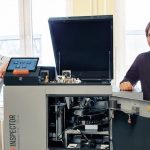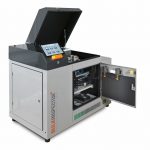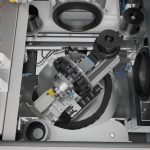Mr Corell, you and Prof. Schwechten from HTWG Konstanz worked together to develop the Bulkinspector Gaspycnometer PYC 130-A. How did this collaboration come about?
Jens Corell: We have known each other for almost 30 years. During a visit to a stand at a trade fair – I think it was at Powtech in Nuremberg – Prof. Schwechten presented to us his concept of a fully automatic and continuously operating gas pycnometer. The concept convinced us, so we started the development of the device.
The PYC 130-A can be used to determine skeleton density. What is the difference between this and normal density?
Prof. Dieter Schwechten: When looking at porous materials, which also includes bulk particles, a distinction is made between skeleton density and bulk density. A skeleton density measurement exclusively takes into consideration the volume of the material component of the porous substance. By contrast, a measurement of the bulk density includes not only the volume of the material component, but also the volume of the enclosed pores. The skeleton density can be determined very well using gas pycnometers, in which the measuring gas penetrates into the open pores and thus makes accessible the material component volume of porous solid particles.
What role does density play in the characterization of bulk materials?
Corell: Under some circumstances, it can replace chemical analysis. This is because density is a substance-specific constant, which for example allows conclusions to be drawn about the purity of substances.
Does it also permit statements to be made about how bulk solids will behave in processes?
Prof. Schwechten: Yes, that too. Among other things, the density affects the compaction behavior of bulk solids, and their flow characteristics.
What methods are available for determining the density of solids?
Prof. Schwechten: A common feature of all methods is that the volume of the body and its mass are determined in separate steps. The density is then calculated from these two values. You probably know the simplest method of measuring volume from physics class. An object gets immersed in a measuring cylinder filled with water, and the volume displaced is measured. The use of hydrostatic scales is significantly more elegant and precise. This uses the buoyancy of an object in water to determine its volume. Gas pycnometers then hit the market around the mid-1950s. The centerpiece of the device is occupied by two chambers. One serves as a sample chamber, the other as an expansion chamber. The material to be analyzed is placed into the sample chamber. The gas from the sample chamber is then allowed to expand into the expansion chamber. Boyle’s Law is then used to calculate the volume of gas displaced by the sample.
What are the benefits of gas pycnometers?
Prof. Schwechten: They are very accurate, and are also suitable for determining the volume of powdered and porous samples.
What measuring gas is used?
Prof. Schwechten: Generally helium. Under indoor conditions it behaves almost like a perfect gas, whose behavior is what Boyle’s Law actually describes. It is also inert, meaning it does not react with the samples. And the helium atoms are so small that the gas can penetrate even the finest open pores.
What are the disadvantages of measuring volume and mass separately when calculating density?
Corell: For one thing, manually transporting the sample from volume measurement to precision weighing makes the procedure far longer. And for another, the sample then gets exposed to different temperatures. This is a big disadvantage, because the volume and thus the density are temperature-dependent variables, which can falsify the measurements. And not least, there is a risk of sample contamination during transportation.
Prof. Schwechten: There is also another factor: Today, processes are monitored, controlled and regulated by means of online sensor technology. This requires fast and reliable methods for measuring density as well. It was against this background that the concept was developed for a fully automatic gas pycnometer with integrated precision weighing technology.
How did you solve this in terms of construction?
Corell: Volume measurement and weighing take place in a closed measuring cell, which is temperature-controlled using Peltier elements. In the measuring cell, a handling device equipped with a gripper transfers the samples from the pycnometer to the precision scale.
Gas pycnometers are differentiated based on their two functional principles – constant pressure gas pycnometers, and constant volume gas pycnometers. Which principle does the Bulkinspector PYC 130-A use?
Prof. Schwechten: Like all conventional gas pycnometers, the Bulkinspector works on the principle of constant volume. There is a sample chamber and an expansion chamber, both have a defined volume and are interconnected via a valve. The sample is placed into the sample chamber via an airlock. The chamber is then filled with helium until the feed pressure P1 has been reached. The valve is then opened and the gas expands into the expansion chamber, as a result of which the equalization pressure P2 is achieved in the chamber. This is recorded, and together with the known volumes of the two chambers it is used in the calculation of the sample volume.
The volume of the very same sample is calculated multiple times. Why?
Corell: This allows us to reduce measurement uncertainties on the one hand, and to quantify them on the other.
What are the main components of the Bulkinspector Gaspycnometer PYC 130-A?
Prof. Schwechten: The centerpiece of the system is the temperature-controlled measuring cell, which houses the pycnometer and the precision scale. Upstream of this chamber is a filling station. This is where the measuring cup, whose empty weight is determined before each measurement, is filled with the sample, temperature-controlled, and finally transferred into the measuring cell via an airlock. Then there is the discharge station. This is where the measuring cup goes after the measurement to be emptied and cleaned with compressed air. And not to forget the handling system that transfers the measuring cup in the device.
Measuring cups for the Bulkinspector Gaspycnometer PYC 130-A are available with volumes of 10, 65 and 130 cm3. Why is this necessary?
Prof. Schwechten: The size of the measuring cup used depends on the sample volume, and this in turn depends on the particle size of the bulk material to be examined. For very fine powders, the sample size required is less than for coarse-grained products.
How many measurements can be performed per hour?
Corell: At least ten measurements.
Samples normally enter the Bulkinspector via a sample magazine, which has space for four measuring cups. Can the device also be combined with an automatic, continuously operating sampling system?
Corell: This is possible, and is what makes our solution attractive, because conventional pycnometers are operated manually and thus discontinuously. It is possible to take samples from a downpipe, for example, from which individual samples are analysed, or to form bulk samples in a sample preparation plant before analysis in the Bulkinspector.
Prof. Schwechten: In combination with sampling systems, our system opens the door to automatic online density analysis, directly on production lines operating 24/7. Density thus ceases to be merely a parameter for assessing the quality of bulk solids and bulk solid mixtures, and becomes a control variable for controlling processes.
And are ten measurements per hour enough for that?
Prof. Schwechten: I believe so. After all, process engineering processes are generally comparatively slow.
And what bulk solids is the Bulkinspector suitable for?
Corell: We are at the beginning here, and assume today that it can be used to determine the densities of all bulk materials.
Prof. Schwechten: Very fine and cohesive powders generally cause problems for gas pycnometers. For example, dust can be generated in powders when the helium flows into the measuring cell or expands into the expansion chamber, which can lead to interference with the measurement. One more point as regards application capabilities: in two-component mixtures, the Bulkinspector can also be used to determine the proportion of the two components. The requirement for this is that the single-component density of the two components is known.
Where do you see possible applications for the Bulkinspector Gaspycnometer PYC 130-A in the chemical and pharmaceutical industries?
Corell: The application spectrum is broad: it ranges from quality assurance in the production of glass fiber and carbon fiber reinforced plastics to measuring the pore volume of open-cell foams or carrier materials for catalysts.
And in the pharmaceutical industry?
Corell: For example, when producing medicines in tablet form. Here, the system can be used to determine tablet compaction on the one hand and to detect pore inclusions on the other. Our Bulkinspector can also detect the latter in lipsticks.
When will Siebtechnik Tema start selling the Bulkinspector Gaspycnometer PYC 130-A?
Corell: The sales launch was on January 3, 2022. The Bulkinspector is therefore available. We also offer interested parties trials with their own product samples. A device is available for this purpose in our technical center. Furthermore, we are planning to make rental devices available within the coming months.
Siebtechnik GmbH, Mülheim an der Ruhr
The interview was conducted by:Lukas Lehmann
Editor
„In combination with sampling systems, the Bulkinspector opens the door to automated online density analysis, right on the production line.“










